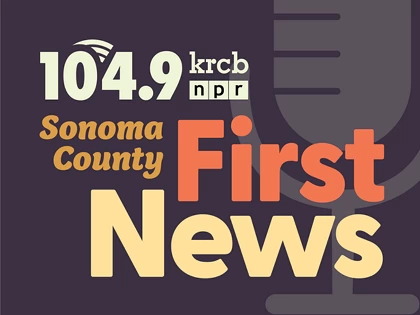 photo credit: Jay Bergesen/Wikimedia
photo credit: Jay Bergesen/WikimediaAnderson Valley in Mendocino County, home to
extensive vineyard acreage, makes up a large
part of the Navarro River Watershed.
A state water regulators meeting...not the kind of thing that makes you think “I’ve got to be there.”
But with new environmental rules on the table for vineyards across Sonoma and Mendocino, there was hardly an empty seat to be found at the latest gathering of the North Coast Regional Water Quality Control Board.
Scores of community members and grape growers packed the board’s meeting room in Santa Rosa.
They were there to take in a presentation on a proposed set of rules meant to protect surface waters - creeks, streams, and rivers - plus groundwater in the North Coast region - from sediment and chemical pollution caused by vineyard activity.
Chris Watt, an engineering geologist for the water board, said threats to protected fish species are one reason for the new proposed rules.
"These watersheds are also impaired and on the federal list of impaired waters for sediment and temperature," Watt said. "Also, within this region is habitat of salmonid species, which have experienced a dramatic decline over the last several decades."
As written, the rules include road construction guidelines and practices like mandated cover cropping, pesticide monitoring, and vegetation restoration at water’s edge.
Experts estimate vineyards in the Russian and Navarro River Watersheds cover close to 65,000 acres - only about 5% of the total watershed areas.
Grape growers have pushed back - with close to 80% of vineyards in the area already adhering to voluntary programs like Certified Sustainable and Fish Friendly Farming. Grape grower Frost Pauli said they feel vineyards are being singled out unfairly.
"A huge majority of vineyards in the two counties are certified sustainable by third parties and vineyards are not discharging waste or pollutants," Pauli said. "It should not be treated like row crops. We just wanna be treated fairly and equally. As a parting suggestion, I suggest you throw out this draft."
One grower described grapes as the commodity with the highest focus on sustainability in the state; and gathering robust data on the impacts of current growing and best management practices - BMP’s - is a big part of proposed rules, said Brenna Sullivan, an engineering geologist on the project.
"This is used as a method to tie those management practices to water quality outcomes," Sullivan said. "In other words, we can assume that these practices may already be widely implemented and the water quality monitoring is a quantitative tool to evaluate and track whether those practices are both working and are protective of water quality."
Brittany Jensen is executive director for the Gold Ridge Resource Conservation District. and said the proposal as written may encourage compliance to the letter, but not the intent of the law.
"The permit feels like it's all stick and no carrot, which kind of means it doesn't support or encourage going above minimum practices," Jensen said. "Reducing monitoring requirements, and associated reduced costs for growers who have already adopted high level BMP's would be a good carrot, for example."
The draft rules are scheduled for a vote at the North Coast Regional Water Quality Control Board’s December meeting.

 Live Radio
Live Radio




